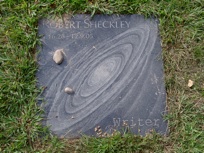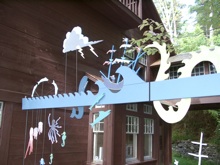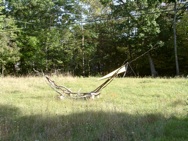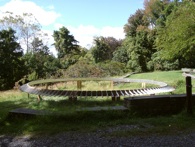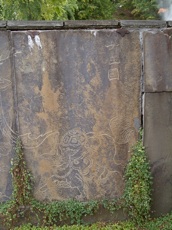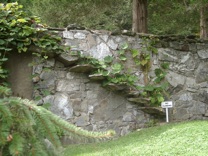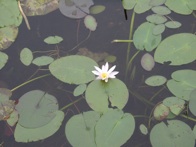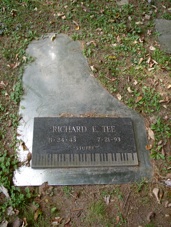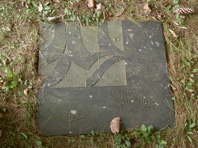arslocii
placeness as art


arslocii
placeness as art
















Quest for artistic endeavor in
the Catskills – Woodstock, NY
What could be better than staying in an arts and culture center in the Catskill mountains near the Hudson River? Not much. Woodstock is not the place where the 1969 music festival took place – that is fifty-some miles away – but it is a spiritual center with a much longer history than the forty years since the event associated with the name. Our purpose in going was to work on writing projects and actually live there, enjoying what the town and its hamlets have to offer. There is much to recommend it. We arrived with a list of things to see and do and, as is often the case, it was the serendipitous discoveries that made the stay better than expected.
First, our rented cottage (which surely must have been an original part of the Byrdcliffe Arts Colony) was an unanticipated joy that enriched the experience – real, homey, with a wall of natural light and a wood stove for creative atmosphere. Tucked away and woodsy, yet completely walkable to the center of town – a best-of-both-worlds situation.
Second, one of the many special things about Woodstock is the personalized signage, not only of the visually lively streetscape in the shopping district, but also the individualistic, handmade and sometimes inspired address markers of houses and studios throughout the town. The artist’s palette is a popular motif, but there are many more unique, brightly colored, elaborately shaped and eccentrically customized designs that brand the territory of yet another creative personage. We’d hate to think that by living here we would become immune, just passing by them without noticing, since they are so plentiful.
The reason we bring up the signs, though, is that it seems as if life in the mountains is often about marking trails, erecting signposts, demarcating the less-noticeable and -significant human component of life in some small way. One can’t compete with the natural world there, one can only leave token way-finding aids, a portion of which indicate where to locate the artistic spirits in among nature’s: signs of intelligent life within the greater intelligence. And with no attempt to overwhelm it either. A very palatable co-existence. And fun for the eyes.
Visual stimuli abound in and around this enclave, not only on the streets but in galleries, museums, outdoors in park settings, on mountains, at the river’s edge and, even, in cemeteries. It’s kind of a full-circle artistic expression that involves every aspect and prospect. Very much an arslocii kind of place.
Byrdcliffe Arts Colony
Woodstock, NY
This more-than-a-century-old settlement on Mount Guardian, just above the town center, is unassuming and yet instantly recognizable as belonging to artists. The simple brown/blue trim cottages have disproportionately-sized windows, much larger than do normal mountain cabins, all the better to capture light to make art with. They are scattered throughout the hilly wooded site but sort of cluster around the main buildings housing the theater, classrooms and gallery. The only other place we’ve been that has this same feel is Arden, Delaware, which began at around the same time and for similar utopian reasons.
To note the 400th anniversary of Henry Hudson’s discovery of the river that bears his name (and his mysterious, mutiny-related demise and never-found body), and as part of the related events going on in and around the historic river valley, Byrdcliffe offered an outdoor sculpture exhibit called, “Ahoy! Where Lies Henry Hudson?” The works were mostly built by architects rather than artists. Of the twelve pieces, few seemed to relate to the initial, vague concept; only a very few actually related in some way to the site; one of them, “The Magnificent Adventure of Henry Hudson,” related to the surrounding architecture; another, “Hudson Museum on the Ecliptic,” related to its site but seemed to have little to do with the concept. The others, generally, were installations that could have been anywhere, inside or out. That isn’t to say that some of them weren’t interesting or intriguing, they just had no connection to where they were – often typical of architect thinking. One of the better expressions is the one pictured to the left – a gesture drawing of a boat made from branches gathered from the site, a ghostly apparition of Hudson’s ship on dry land – and unidentified in the catalogue, making us think that some rogue artist snuck in and made a powerful statement outside the official aegis of the show.
The exhibit itself managed to achieve what some of the pieces did not – to send the viewer on a journey of discovery. And, after all, that’s what so many of the entries – and Hudson’s own adventure – were supposed to be about, but, like Hudson, were lost at sea.
Martin Puryear Prints
Woodstock Byrdcliffe Guild, Kleinert/James Arts Center
On Woodstock’s main drag, Tinker Street, Byrdcliffe has its own museum-quality shop with the attached Kleinert/James Arts Center. Martin Puryear’s sculptures are things of beauty that cross all boundaries of fine art, craft and folk art, so we didn’t know what to expect from his prints. The same, it seems. Two distinct groups: woodblock prints and etchings, the former very dark, the latter mostly light. We were drawn to the etchings with their more sculptural renderings – volumetric, dimensional, simple complexity. The gallery, an amazingly generous bi-level space (a performance space?) was encircled by the graphic shapes. Too bad there wasn’t at least one Puryear sculpture to hold the room.
Woodstock Farm Animal Sanctuary
Willow, NY
As vegetarians, we think that the concept of saving victims of husbandry is a noble pursuit. After reading “The Omnivore’s Dilemma,” by Michael Pollan (and now underscored by Jonathan Safran Foer’s “Eating Animals”), seeing these rescued animals was a necessity, to make up in some small way for the cruelty and slaughter of innocents by the millions on any given day in factory farms. What is truly remarkable about the Sanctuary is the sense of well-being and love deservedly being bestowed on these fellow creatures, the lucky ones. It is not a zoo, it is a home. And the animals who thrive there – sheep, goats, steer, pigs, chickens, ducks and a turtle – live their lives without fear, interacting with humans in a co-dependency of respect and belonging as well as in harmony with their own species. It is truly the peaceable kingdom. Listening to the horror stories of their lives, pre-Sanctuary, is hard to take but, unlike so many situations in life, this is the happy-ending place.
We are giving this unique site an arslocii designation because of the special relationship of these animals to the land they now inhabit and the spiritual connection of the two. The meaning of this pairing is exhilarating, proving the point that humans can sometimes rise above themselves and express something worthy of the often falsely-assumed status we think we have.
Innisfree Garden
Millbrook, NY
Not so far away from Woodstock, on the east side of the Hudson, is a garden collection that harkens to someplace that is very far away. Hidden in a hollow of woodland hills, its terrain perfectly expresses its overriding theme of a Chinese cup garden – a picture gallery of connected but unique, framed vignettes. Once a private estate garden, much of the complex design was done by landscape architect Lester Collins (our friend from the Hirshhorn). Using the natural features of the site to best effect, the design’s Asian concept is remarkably rendered, and the land is transformed by use of rock outcroppings, streams, native plants and mosses into still-life tableaux that could be attributable to Northern Song Dynasty paintings (the “Great Age of Chinese Landscape”). Some of the gardens even have etched panel walls – images of fashionable Chinese women making offerings to appease a unicorn/lion god, a mythological signifier of the kind of detailed effect produced by the authenticity of the garden effort. The natural stone in this region is a big player in the beauty of this collection, as are the waterways – especially the glacial lake that is the centerpiece of the garden that encircles it and crosses it on a long narrow footbridge. The journey through this unique series of settings is not unlike a pilgrimage with its stations and silent meditations and, sometimes, challenging topography. Fascinating, when you travel the paths of this garden so near the Hudson River and think about Henry Hudson looking for his route to Asia. I think we found it.
Artists Cemetery
Woodstock
We were not looking to wander through cemeteries, but we saw this one ducking behind the main drag with no signage (nothing to indicate a staked claim, unlike other places in Woodstock). A simple hill, a few trees at the top – an island behind the town – some unusual tombstones even at street level. We returned, we explored. What we found was amazing. At the top of the hill stands a monument facing the other side of the slope, a simple stele of native stone: the Shotwell Pillar. Etched into its face are the words: “Encircled by the everlasting hills, they rest here who added to the beauty of the world by art, creative thought, and by life itself,” attributed to Dr. James T. Shotwell. Artists: honored in death, if not in life. But this side of the hill looked bare. On closer inspection, we discovered in-ground stones scattered about, varying in size and shape. Here is Hervey White, who led a group, the Mavericks, that split off from the original Byrdcliffe artists led by Ralph Radcliffe Whitehead and Jane Byrd McCall – who are also here in the cemetery. Buried here are visual artists, writers, musicians, performers and intellectuals – all together in this small death site, the most appealing one we have ever seen. The stones are individualistic, creative, sad, clever, beautiful, stylized, plain and fancy – but all are flat and snug to the ground. In the Memorial Society’s mission statement, it says that the design is “as one landscaping unit that preserves ... the uninterrupted beauty of its natural slope and surface.” It does, and it should. Still, the artists have managed to add to the beauty on their flat palettes, leaving their signage on the surface of the lovely slope for all eternity. Also included with the 19th-century crowd are some well-known 20th century creative, but no longer active, minds (Milton Avery and Philip Guston, for instance). It was a privilege to wander in among them. Cemeteries are always physical reminders of our ends, sometimes personalized by tombstones but more often standardized in the same way that life standardizes us. The fact that there is a sensitivity here to the creative dead makes it a little more acceptable, allowing us to view it in an arslocii way. In some “Through the Looking Glass” sense, the stones and their placement become an in-ground permanent gallery for all to stroll through and enjoy. What could be a better end for creative people – to always have their work seen and remembered?
Cairns and Mounds
Daisy
While visiting the Woodstock Artists Association and Museum, we noticed “an unauthentic Map of Woodstock County of Ulster...” from 1926, a rendering of the town indicating where all the artists lived at that time, including little sketches of each property with the owners’ names, plus points of interest in the area. Indian Caves and Quarry are indicated sites and, after a small amount of investigation on our part, it turns out that at those locations there are a number of prehistoric rock shelters (2000 b.c.e. to 1750 c.e.) – several dozen rock structures and cairns, some up to 100 feet in length, found mostly near waterways – left around the base of Overlook Mountain, possibly by the original inhabitants. Mentioned in deeds from the early 1800s as “ancient monuments,” and used then as landmarks for surveying purposes, the mysterious structures persist in being un-understandable. Despite the uncertainty as to what the purpose of the formations was, there are theories about the Catskills having been used by three different native tribes as burial grounds and, therefore, sacred sites. We tried to explore one area that was said to have a few cairns but we never found them; probably they were hidden by decades, if not centuries, of plant growth. We will have to return and ask for help in locating them. It is truly a compelling idea that could potentially be the most primal of arslocii. Can’t wait.

arslocii, a creation of Probasco Haus Press
copyright © 2010 Probasco Haus Press LLC

Top Left: Artists Cemetery, stone marker.
Bottom Left: Byrdcliffe with attached portion of one of the outdoor sculpture entries,
“The Magnificent Adventure of Henry Hudson.”
Right: Innisfree Garden’s long walk across Tyrrel Lake.
